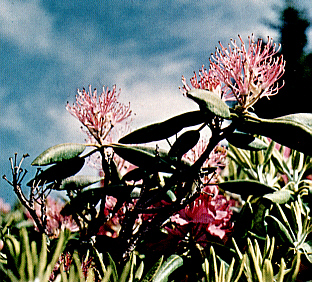Stay, Men; This is the End
David Leach, North Madison, Ohio

|
|
R. catawbiense
, staminoid form
Photo by David Leach |
Having once written an article for the
Bulletin
on photographing rhododendrons entitled
How To Shoot A Pistil
, I should not have winced when I saw the caption,
Pistil Pete Meet Pistil Packin' Mama
, on the article by H. J. Slonecker in the October
Bulletin
. Having survived the title, I plunged ahead to the very end of the piece describing two forms of
R. occidentale
which virtually lack corollas. The concluding paragraph invites information on other, similar aberrations in rhododendrons.
The condition is not common but neither is it as rare as might be supposed. A few years ago, while I was scouting
R. catawbiense
on Roan Mountain, North Carolina, I encountered a plant which bore both staminoid and normal flower trusses, the former illustrated by the accompanying photograph. The five corolla lobes in the aberrant flowers had been transmuted to stamens, so that each consisted of 15 stamens plus a normal pistil, giving the whole truss a bristly appearance which seemed to me grotesque and unattractive. The anomaly is not quite the same as that described by Mr. Slonecker, but the visual result differs little.
I have since encountered several other similar mutants in species of both the Taliense and Ponticum series, and occasionally in hybrid seedlings from my own crosses. Seedlings from crosses with 'Boule de Neige' are especially likely to exhibit gross flower malformations. In fact, I abandoned this cultivar as a parent years ago because of this propensity.
The Japanese have encouraged and selected deviates in both leaf and flower of persistent leaved azaleas, and presumably through hybridization of mutants, have produced such exotic cultivars as 'Seigai' which are virtually unknown in this country. 'Seigai' leaves resemble those of an Asiatic maple; few would identify it as an azalea of the Obtusum Subseries. There are Japanese azaleas with narrow, elongated and fully divided corolla lobes which are very handsome.
These may be derived from one of the forms of
R. macrosepalum
with narrow, strap-like and widely separated flower petals, of which the best known in this country is var.
linearifolium
. Others known in Japan, which vary principally in the width of the petals and degree of separation, are 'Hanaguruma', 'Kinkujaku' and 'Amegashita', all pink; and 'Shiroamegashita' and 'Shirohanaguruma', both white.
They may also descend in part from one of two forms of
R. kaempferi
. 'Kinshibe' is an exact duplicate in an Obtusum Subseries azalea of the staminoid flowers illustrated on
R. catawbiense
. The corolla is completely lacking. The Japanese also know a
kaempferi
forma
angsdisectum
, which has long, pink, totally divided corolla lobes not more than a quarter of an inch in width. It is quite similar in floral effect to yet another wild azalea,
R. indicum
forma
otakumii
, which is native to Japan.
Thus the Japanese have had ample resources from which to breed their hybrids of exotic appearance. Of these 'Kinzai' is among the most unusual. The orange-red petals of this clone are fully separated, narrow, spatulate and are positioned at varying angles to the base of the flower. The result is striking. Not so attractive to western eyes is 'Karaito', also orange-red; most of the twisted stamens are naked but some have ragged bits of petal clinging to them. There is no corolla. 'Chojuho' is more conventional; the narrow, reflexed scarlet petals produce appealing star-like flowers, and from them issue greatly elongated stamens and style. Perhaps the bizarre flower forms of our native azaleas and rhododendrons present opportunities for the breeder to produce novel and attractive floral effects.